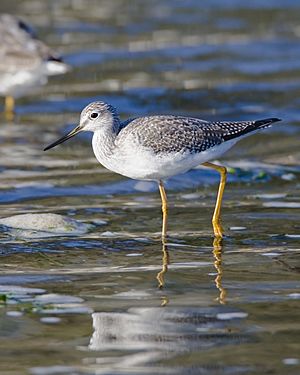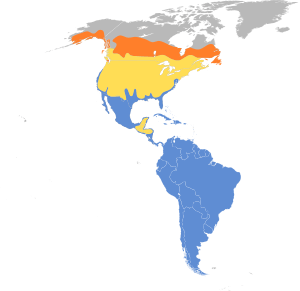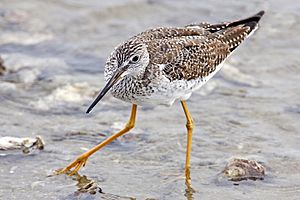Greater yellowlegs facts for kids
Quick facts for kids Greater yellowlegs |
|
|---|---|
 |
|
| Conservation status | |
| Scientific classification | |
 |
|
| Synonyms | |
|
Totanus melanoleucus |
The greater yellowlegs (Tringa melanoleuca) is a large North American shorebird. It is known for its long, bright yellow legs. This bird gets its scientific name, melanoleuca, from Ancient Greek words meaning "black" and "white". This describes its body colors.
Contents
About the Greater Yellowlegs
The greater yellowlegs looks a lot like the smaller lesser yellowlegs. However, it is a bit bigger. These birds have long yellow legs and a thin, dark bill. Their bill curves slightly upwards and is longer than their head.
What They Look Like
Adult greater yellowlegs are grey-brown on top. Their underside is white. Their neck and chest have dark brown streaks. The back part of their body, called the rump, is white.
These birds are about 29 to 40 centimeters (11 to 16 inches) long. They weigh between 111 and 250 grams (about 4 to 9 ounces). Their wings can spread out to about 60 centimeters (23.6 inches).
Reproduction and Migration
Greater yellowlegs breed in wet, marshy areas. These areas are found in the northern forests of Canada and Alaska. They build their nests on the ground. Nests are usually well hidden near water.
Eggs and Young Birds
Female greater yellowlegs lay three to four eggs. Each egg is about 50 millimeters (2 inches) long and 33 millimeters (1.3 inches) wide. They weigh about 28 grams (1 ounce). The eggs hatch after about 23 days. The young birds leave the nest very quickly, usually within a day of hatching. They move away from the nest area within two days.
Where They Travel
After breeding, these birds fly south for the winter. They travel to the Atlantic and Pacific coasts of the United States. Some go to the Caribbean or even further south to South America. It is very rare to see them in western Europe.
What They Eat
Greater yellowlegs find their food in shallow water. They sometimes use their bills to stir up the water. This helps them find hidden food.
They mostly eat insects and small fish. They also enjoy crustaceans, like tiny crabs, and marine worms. When they walk in sand or mud, they leave clear tracks. These tracks can help people learn about the birds.
Their Call
The call of the greater yellowlegs is easy to recognize. It is louder and clearer than the call of the lesser yellowlegs. When they fly, they often make a three-syllable whistle. The last syllable of their whistle is lower in pitch.
See also
 In Spanish: Chorlo mayor de patas amarillas para niños
In Spanish: Chorlo mayor de patas amarillas para niños



